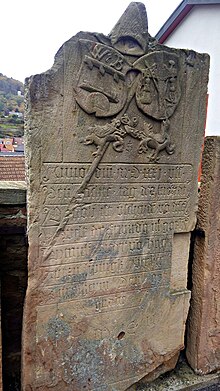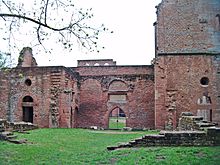Werner Breder von Hohenstein

Werner Breder von Hohenstein (* in the 15th century; † October 8, 1531 in Bad Dürkheim ) was a noble Benedictine and abbot of the Limburg monastery .
Origin and family
He came from the ministerial family of the Breder von Hohenstein , who lived in the Taunus and died out in 1605 , who lived as heirs and castle men at Hohenstein Castle and owned it since 1446. The nearby Greifenstein Castle is named as the original seat of that sideline of the Lords of Hohenstein . His father Conrad Breder von Hohenstein died in Kiedrich in 1505 and was in the personal service of Landgrave Heinrich III. of Hessen . He was buried in the parish church of St. Valentin zu Kiedrich , the grave slab is now outside. The mother's name was Elisabeth Brendel von Homburg .
Werner's brother was Philip VII Breder von Hohenstein, Teutonic Order - Commander in Würzburg and governor of the Ballei Lamparten . Both sister Elisabeth lived as a choirwoman in the Palatinate monastery of Hane .
Live and act
Werner Breder von Hohenstein became a Benedictine in the Sponheim monastery , and the Limburg abbot Machar Wais von Fauerbach appointed him provost of his branch convent in Naumburg in 1505 . The year before, the Limburg Abbey had burned down and from 1508 it was temporarily relocated to nearby Wachenheim on the Weinstrasse . Abbot Machar Wais von Fauerbach wanted to re-establish it there, but died in 1509. Werner Breder von Hohenstein was unanimously elected as his successor because he had proven himself as superior in Naumburg. He is characterized by the historian Franz Xaver Remling as peaceful, pious and humble. Because of the sad state of the Limburg Abbey, he took over the new office for a year on probation before finally making his decision. He sent Johann von Deidesheim, who had previously been active in Wachenheim, to Naumburg as provost. Breder von Hohenstein gave up his predecessor's resettlement plans and decided to build Limburg Abbey on the old square.
To this end, he wanted to first meet with the destroyer of the monastery, Count Emich IX. reconciling from Leiningen-Hardenburg . Three abbots, the Speyer Cathedral Provost Georg von Gemmingen and Count Ludwig I von Löwenstein , who was also asked to act as mediator, brought about the reconciliation in 1510, whereupon Werner Breder von Hohenstein reinstated the Leininger in his old Limburg fiefdom and waived compensation for the burning of the monastery . Then he immediately set to work on the clearing up and construction work, for which he asked Elector Ludwig V of the Palatinate for support. By order of the latter, every Oberamt in the Electorate of the Palatinate had to park two carts with an operating team for work on the Limburg. The rubble was cleared away, the walls that were preserved were exposed and construction work began. In order to be able to better monitor and control the work, the abbot moved the provisional convent to the Limburg official cellar in Dürkheim.
First of all, Abbot Breder von Hohenstein had the western front of the church rebuilt with a new Gothic main entrance and the vaulted room behind the northern west gate set up as an emergency church . This work was completed in 1515, the church ruins could be closed again and used as a makeshift. Breder von Hohenstein had a coat of arms plaque placed above the Gothic main portal, which was built at the time and still exists . However, the associated niche has been preserved and since the 19th century has housed another stone tablet on the history of the abbey. The restoration of the convent buildings and the cloister began . Due to the lack of money, however, the renovation progressed very slowly. In 1525 , during the Palatinate Peasants' War , farmers from Bockenheim plundered the abbey again.
Werner Breder von Hohenstein died in 1531 in his emergency home in Dürkheim; Until then, Limburg had not yet been restored to being colonizable. He was buried in the local St. Johanneskirche (today the castle church) in front of the high altar, his tombstone is now outside, north of the church.
Apollo von Vilbel († 1536), who continued the construction of the ruinous Limburg, was chosen as his successor .
literature
- Franz Xaver Remling : Documented history of the former abbeys and monasteries in what is now Rhine Bavaria , Volume 1, pp. 142–144, Neustadt an der Haardt, 1836; (Digital scan)
- Johann Georg Lehmann : History of the Limburg Monastery near Dürckheim an der Haardt , Frankenthal (Pfalz), 1822, p. 77 and 92; (Digital scan)
- Wilhelm Manchot : Limburg Monastery , Mannheimer Altertumsverein, 1892, pp. 28–31
- Johann Adam Bernhard : Wetterauischer Alterthümer, Partis Specialis , 1. Department, p. 34 u. 35, Hanau, 1734; (Digital scan)
Web links
Individual evidence
- ^ History of the Breder von Hohenstein with Jodocus Breder von Hohenstein 1459, Kiedrich. Grave monuments in Hesse until 1650. In: Landesgeschichtliches Informationssystem Hessen (LAGIS).
- ^ Adolph Genth: Kulturgeschichte der Stadt Schwalbach , Wiesbaden, 1858, p. 204; (Digital scan)
- ^ Georg Joseph Kleiser: The history of the families Kleiser, Broder, Henneberg , 1987, p. 122; (Detail scan)
- ↑ Yvonne Monsees: The inscriptions of the Rheingau-Taunus-Kreis , 1997, p 285, ISBN 3882269693 ; (Detail scan)
- ↑ Grave slab of the father with biographical information in Konrad Breder von Hohenstein 1500 or 1505, Kiedrich. Grave monuments in Hesse until 1650. In: Landesgeschichtliches Informationssystem Hessen (LAGIS).
- ↑ Johann Samuelersch u. Johann Gottfried Gruber : General Encyclopedia of Sciences and Arts , 2nd section, 9th part, p. 402, Brockhaus Verlag, Leipzig, 1832; (Digital scan)
- ^ Franz Xaver Remling: Documented history of the former abbeys and monasteries in what is now Rhine Bavaria , Volume 1, p. 144, Neustadt an der Haardt, 1836; (Digital scan)
- ↑ Antenne , Zeitschrift der Prot. Kirchengemeinde Bad Dürkheim, June 2016, page 13 (PDF document) ( Memento from November 3, 2016 in the Internet Archive )
| personal data | |
|---|---|
| SURNAME | Hohenstein, Werner Breder from |
| BRIEF DESCRIPTION | noble Benedictine monastery and abbot of Limburg |
| DATE OF BIRTH | 15th century |
| DATE OF DEATH | October 8, 1531 |
| Place of death | Bad Dürkheim |
